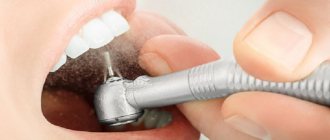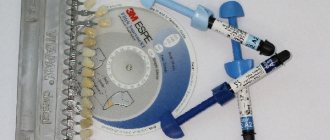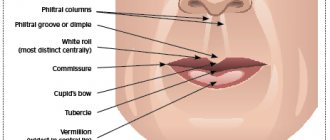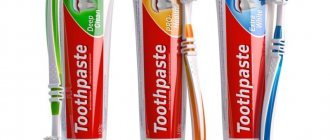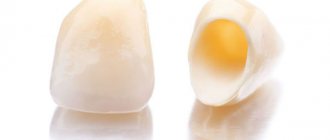Indications for placing a temporary filling
- Treatment of deep caries. After cleansing the tooth cavity from necrotic masses, the dentist places a medicinal solution that helps the dentin strengthen the layer between the pulp chamber and the open cavity.
- Diagnosis of the condition of the tooth with deep caries before installing a permanent filling.
- Acute pulpitis. A temporary intermediate composition is placed while the nerve is removed.
- Periodontitis. To relieve inflammation, an antiseptic or medicinal preparation is placed in the area of the tooth roots, which is then covered with light cement.
- Sanitation of dental canals before filling. The doctor cleans the canals, filling them with a disinfectant solution, then places a temporary filling.
- Prosthetics, restoration. The process of making an artificial crown or orthodontic structure takes several days. To protect against microbes, the open tooth cavity is closed with a temporary filling material.
Stages of placing a temporary filling:
- opening the tooth cavity, removing all affected dentin tissue;
- expansion, cleaning, treatment of dental canals;
- therapeutic stage (depending on the diagnosis, the nerve endings of the pulp are removed, medications are placed in the tooth cavity, and the canals are filled with temporary cement);
- The crown is closed with a temporary filling.
What determines the maximum wearing period?
The maximum wearing period is determined by the dentist individually.
The maximum period of wearing a temporary filling depends on several factors:
- method of treatment;
- type of filling material used;
- means for filling into the tooth cavity.
The drilled hole may not reflect the full picture of the disease or may require further placement of medication. A temporary filling in this context serves as an auxiliary diagnostic function.
Short-term operation of the insert requires high-quality installation of the filling mass with hermetically sealed closure of the cavity in the tooth. This will ensure reliable fixation of the embedded drug and prevent food particles from penetrating inside. Previously, to suppress the sensitivity of the nerve, arsenic was inserted into the cleaned tooth hole. At the same time, the filling could not be kept for long and had to be replaced after 72 hours.
Modern dentists prefer to use other drugs, which increases the period of wearing a filling insert from 5 days to 3 weeks . If the patient needs long-term treatment, then reflective material is used as medical cement (lasts from 3 to 6 months).
Material of manufacture
Requirements for temporary filling materials:
- no toxic effect on tooth structures (enamel, dentin, pulp) and mucous membranes of the oral cavity;
- safety for human health;
- chemical inertness and high resistance to saliva and aggressive environments (alkalies, acids);
- mechanical strength, wear resistance, ductility;
- lack of galvanization effect;
- maintaining shape and size during hardening;
- good radiopacity.
The choice of material for a temporary filling depends on the clinical case, age, individual characteristics of the body (the presence of allergies to certain substances), as well as how long the patient will wear it.
What types of fillings are there?
Depending on the period of use, temporary and permanent fillings are distinguished. The first ones are placed during treatment. For example, they cover a tooth for a while in order to understand whether the nerve is affected by caries or not. A temporary filling is also used to secure medications placed in a diseased tooth, or to secure arsenic after depulpation. After two weeks, temporary materials are replaced with permanent ones. The latter can last for years.
In modern dentistry, the following types of fillings are distinguished:
- Cement fillings are a budget option. They are difficult to grind, look unnatural and can cause destruction of the teeth they interact with.
- Metal (almagamic). They are made from an alloy of silver and copper, are characterized by increased strength, but also stand out against the background of the rest of the jaw. Often, fillings of this type are installed on teeth located further than the incisors.
- Composite fillings. They have a paste-like consistency and are applied in layers, so working with them does not cause much difficulty. Special ultraviolet light is used to fix composite materials. The variety of the palette allows you to choose a shade that will not differ from the native enamel, which is why composites are widely used for the restoration of anterior teeth.
- Ceramic fillings. In appearance and composition, they are as close as possible to the natural coating of teeth. Their production takes some time, so the fixation of the material is carried out in several stages. Ceramics are resistant to temperature changes. Its main advantage is also aesthetics.
Intermediate filling materials
- A paste based on zinc sulfate and kaolin allows you to restore the crown of the tooth.
- Karyosan has an analgesic and antiseptic effect.
- Vinoxol is an artificial dentin. Withstands chewing load for up to 1-2 months.
- Cement with zinc and eugenol. It is used for antiseptic treatment of tooth tissue and relief of the inflammatory process.
- Glass ionomer cement is used for temporary fixation of the prosthesis.
- One-component polymer materials are pastes with a viscous consistency that harden under the light of a special lamp.
Types of permanent fillings
Permanent fillings are different, but if we talk about rough classification, they can be divided into three large groups: metal , cement and composite fillings . Let's start with traditional metal fillings.
Metal fillings
Metal fillings are also called amalgam fillings . Such fillings are strong and durable, however, they have many disadvantages. For example, a metal filling is toxic, so it must be installed by a qualified doctor. In addition, an amalgam filling takes three to four hours to harden. During expansion of the filling, the tooth wall that is in contact with the filling may fall off.
Cement fillings
Cement filling can be divided into two types, in particular it can be phosphate and glass ionomer. Phosphate filling is already outdated, it has little strength and is prone to abrasion, so such fillings are practically not installed.
Glass ionomer fillings are similar in nature to natural teeth. In addition, such a filling includes a special component that reduces the risk of secondary caries.
Composite fillings
Composite fillings can be made from porcelain, acrylic, epoxy, and also from a special light-curing material. Porcelain fillings are durable and, unfortunately, toxic. Acrylic fillings are fragile, but not subject to abrasion. The most optimal are light-curing (light) fillings, however, their cost is quite high.
How long does it take to wear a temporary filling?
Depending on the material of manufacture, a temporary filling has different characteristics of strength and tightness and can last from several days to six months.
Average duration of use of a temporary filling:
- 2-3 days, if a drug is placed under the filling that destroys the nerve endings of the pulp;
- 7–10 days while treatment of the inflammatory process with periodontitis or pulpitis continues;
- 2-3 weeks - for the period of manufacture of the orthopedic structure;
- several months in special diagnostic cases (when treating a dental cyst, restoring dentin after deep caries).
It is necessary to strictly adhere to the timing of wearing temporary fillings. If the time period is extended, its integrity and sealing may be compromised, which will negatively affect the health of the tooth. Thus, arsenic-based paste, if not removed after 2-3 days, begins to penetrate the dentin through the tubules, destroying bone tissue.
How long a temporary filling can be worn is decided by the attending physician, depending on the diagnosis and the chosen treatment method.
Removing a temporary filling is a mandatory procedure before placing a permanent filling. After removal of the temporary composite, antiseptic treatment of the root canals and dental cavity is carried out. Next, a permanent filling is installed.
How the procedure works
For uncomplicated caries, filling is carried out after removing pathologically changed areas of the tooth, cleaning and treating the resulting cavity.
Photopolymer fillings harden under the influence of light radiation. In case of pulpitis, the doctor, after treating and cleaning the canal, fills it with plastic material - gutta-percha - this is a special rubber that hermetically fills the canals of the tooth. First, the doctor may place a temporary filling for a couple of weeks, or sometimes even a month, to make sure that the treatment was successful.
Problems that arise when installing a temporary filling
Painful sensations can be caused by an incompletely destroyed nerve, infection under the filling, or the development of inflammation.
The filling falls out or crumbles. If you do not immediately consult a dentist, the treatment will have to begin again with re-sanitation of the canals, treating them with antiseptics to stop the development of infection.
An unpleasant taste in the mouth often indicates depressurization of the temporary coating, when the medicine from the tooth begins to leak into the oral cavity.
Darkening of the filling, swelling or redness of the gums may be signs of an allergic reaction to a component of the filling material.
What are permanent dental fillings?
Permanent fillings differ in the material from which they are made. Most of the materials that dentists used to use to put fillings are no longer used today. These are various metal alloys that have become a thing of the past due to their high thermal conductivity (they could cause overheating of the pulp), dentistry has abandoned most plastics due to their toxicity and fragility, many types of cements are not used due to their inability to imitate color and density natural tooth, and also because they required thorough grinding of healthy tissue.
Read also: Information letter, vacation
Modern dental fillings are made from composite materials. And here they are presented in two main varieties - chemical and light fillings. The first is so named because it requires a chemical reaction to harden, the second hardens under the influence of a special blue light, which is produced using a dental lamp.
Tags
pulpless tooth restoration of teeth after root canals assimilate a tooth with your tooth with Saving a tooth the front tooth of this tooth or filling teeth. filling a tooth. Treatment of the rootsneed treatment of the rootsafter canal treatmentafter canal treatment Canal treatmentin canal treatment cost of treatment cost of treatment with treatment carried out subafter treatment this doctor can fully. The doctor is always and whose doctors
gingival mouth prosthetics servicesbite implantationcontactsarticlepulpitacrownpromotionswhiteningreviewyearhygienebigbracesdatahelppoliciessurgeryprofessionalappointmenttherapistveneersbetterpersonalphonedevelopment
What anesthesia is used?
Anesthesia is not necessary during tooth filling. If the lesions are small, the filling procedure can be performed without pain relief. Often it does not cause any discomfort to the patient and is carried out quite quickly.
In cases where the lesion has many lesions or is very deep, the patient may be given local anesthesia. To do this, one or more injections are made into the gum near the diseased tooth.
In some cases, general anesthesia may be used. However, it is used extremely rarely. Usually it is resorted to when it is necessary to carry out treatment in young children or patients who are terrified of such interventions.
Where can you get your teeth treated in Novosibirsk?
The Estetika clinic has been operating for more than 20 years, has 9 dental clinics and a diagnostic room equipped with modern X-ray equipment. We employ real professionals: orthopedists, orthodontists, surgeons, periodontists, etc. You can make an appointment with any dentist either on the clinic’s website or by phone.
We offer all types of dental diagnostics and treatment. If it is impossible to preserve natural teeth, we can carry out high-quality implantation using the world-class systems “Ankylos”, “Osstem” and “ASTRA TECH”, which have impeccable characteristics and a manufacturer’s warranty.
The articles published on the site are for informational purposes only, and the services described may not correspond to the list of services provided in the dental clinic. Please check with the administrator for the availability and cost of procedures.
Why does a filled tooth hurt?
Acute pain or aching painful discomfort after the installation of a temporary filling is a very common phenomenon. This is a variant of the norm, so do not rush to accuse the doctor of negligence. There may be several possible causes of concern.
- The medicine has not yet taken effect, which means the pulp has not yet lost its sensitivity. In this case, still living nerve endings will make themselves felt when biting. For the same reason, a tooth may suddenly ache at night.
- Periodic aching pain is a sure sign of an allergic reaction that could be provoked by the filling material. It is dangerous to endure and wait for a planned visit to the doctor - all this can result in a serious complication. The sooner the dentist removes the allergen, the better.
- The tooth may hurt if the temporary filling falls out. This can happen while brushing your teeth or eating. Painful sensations in this case are provoked by an infection that gets inside the tooth.
A temporary filling installed after removal of the nerve does not cause pain, because a tooth without pulp completely loses its sensitivity.
As a rule, when installing a temporary filling, the dentist warns the patient about possible painful discomfort and tells how to get rid of the discomfort. These could be special baths, rinses, temporary abstinence from certain foods, etc. If all the doctor’s instructions are followed in full, but the pain still does not go away, you can try using folk remedies.
- Rinsing. A salt-soda solution, chamomile decoction or sage tincture are perfect for this purpose.
- Compress. It’s not difficult to make: just soak a cotton ball in mint or lemon balm tincture and apply it to the sore tooth.
- Painkiller (analgin, ketorol, nimesil, ketanov). You should not take it at your personal discretion; it is better to check with your doctor in advance which pill you can take if something happens.
As soon as pain occurs, the first thing you need to do is carefully examine the gums near the filled tooth. Redness and/or suppuration is a reason to immediately seek dental care.
Light-curing filling: advantages and installation features
A more accurate name for this dental composite material is photopolymer filling. The prefix “photo-” indicates that special light is needed to cure the filling, and polymers are composite materials.
A light filling gives the dentist the opportunity to accurately reproduce a full-fledged tooth, because, unlike a cement filling, it hardens only under the influence of a lamp. However, it is worth remembering that over time, even the best light-curing filling will darken or become noticeable at the border with the enamel. Therefore, and also because it may fall out at the end of its service life, the structure requires timely replacement, on average, once every five years. As for installing fillings on the front teeth, modern dentistry suggests using ceramic inlays instead. They are better, imitate natural tissues, last longer and are practically invisible on the teeth even after several years.
Content:
- Why are temporary fillings placed?
- Why use it - indications for use
- How long can you walk with such protection?
- Manufacturing materials
- How does the installation work?
- Rules of care
- If the coating collapses prematurely
- How does the replacement work?
Often, patients at dental clinics are faced with a situation where the doctor gives them a cheap intermediate filling and indicates the day when they need to come back for a follow-up appointment to replace it with a permanent one. We suggest you understand this treatment tactics and its features.
If the coating collapses prematurely
It happens that one day a person notices that the carious cavity is left without protection. No need to panic. The fact that a diseased tooth is open to invasion by pathogenic microflora is bad, but it is easy to fix. You should immediately visit your dentist to have it refilled.
If for some reason it is impossible to do this, and the visit has to be postponed by several days, you should monitor the condition of the “hole” and ensure that food debris does not collect in it. See your doctor as soon as possible.
Under no circumstances should you close an open cavity with chewing gum, gauze, cotton wool or other improvised means. These measures will worsen the situation - they will increase the likelihood of infection entering the deep tissues of the tooth.
Correct positioning
Often complex treatment of pulpitis or periodontitis cannot be performed in a single session:
- During the initial treatment, the dentist usually diagnoses the diseased tooth and opens it with drilling.
- The tooth is processed, a temporary expansion of the root canal occurs to remove pus or damaged areas of the tooth.
- After this, cleansing, removal of nerves and other manipulations during treatment occur.
- A temporary filling is placed over the exposed tooth to prevent germs from entering the open cavity.
Such cleaning of the canals may be required more than once, so the doctor must wait until the patient is pain-free before placing a long-term filling. Once the toothpaste has hardened, you should handle it with care as it is usually quite fragile.
In the first hours, it is not recommended to eat food or chew gum. During treatment, switch to a toothbrush with very soft bristles.
How does the replacement work?
When the medicine under the protective “barrier” stops working, a permanent filling is installed. Using a drill, the doctor removes the remaining temporary material. Then it carries out antiseptic treatment of the opened tissues. Makes sure there are no complications and then places the permanent material.
All manipulations are carried out in one visit to the doctor. They are usually comfortable and do not require the use of painkillers - after all, the inflammation has already been cured and the nerve has been removed.
Rules of care
A temporary “barrier” is less durable than a permanent one. He is able to cope with the chewing load for up to two to three weeks. If you "carry" it, it will collapse or fall out. In this regard, until the dentist replaces it with a permanent one, it is important to follow the following rules:
- Avoid eating too solid foods. Nuts, crackers, seeds, etc. are prohibited.
- Do not use chewing gum or sticky candies.
- Carry out hygienic cleaning twice a day - in the morning and in the evening after meals. Use only a brush with soft bristles.
- Do not use a paste containing abrasive particles during treatment.
- After each meal, hygienically rinse the mouth with warm water.
By keeping these rules in mind, you can significantly reduce the likelihood of destruction of the established composition.
